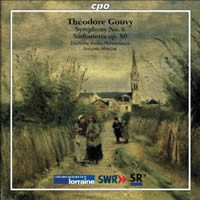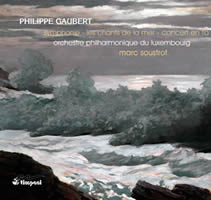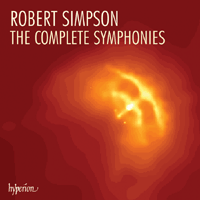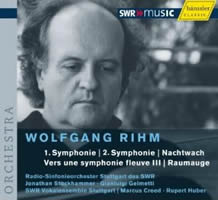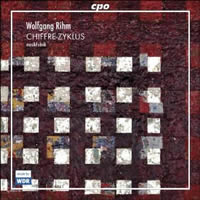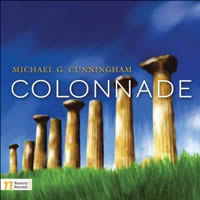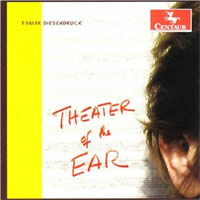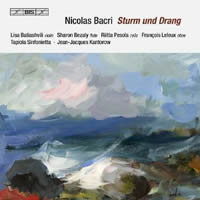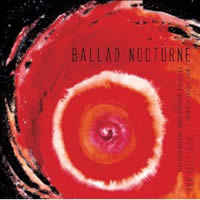Mostly Symphonies 14.
|
Grant Chu Covell [September 2010.]
Louis Théodore GOUVY: Symphonie No. 6, Op. 87 (1889-92); Sinfonietta, Op. 80 (1885). Deutsche Radio Philharmonie Saarbrücken Kaiserslautern, Jacques Mercier (cond.). cpo 777 380-2 (http://www.cpo.de/). Distributed in the US by Naxos (http://www.naxos.com/). Independently wealthy Gouvy wrote amiable, conservative symphonies while the rest of France dallied with operas and ballets. As one would expect, he had more successes in Germany. These late works recall untroubled Mendelssohn and Weber, and aspects of the Sinfonietta hint at Brahms’ Serenades (1857, ’59). The Sixth’s labored-over gravitas is Berlioz-weight. Contrasted against the symphonies of clever Bizet (1855) and stern Franck (1888), and considering that there are so few 19th-century French symphonies, Gouvy warrants a listen. Mercier and cpo appear to be manufacturing a series: Nos. 3 and 5 are on cpo 777 379-2. Sterling, which has brought elegance to so much forgotten fare, has released the Second.
Philippe GAUBERT: Symphonie en fa (1935-36); Les Chants de la mer (1929); Concert en fa (1932). Orchestre Philharmonique du Luxembourg, Marc Soustrot (cond.). Timpani 1C1135 (http://www.timpani-records.com/). Distributed in the US by Qualiton (http://www.qualiton.com/). Gaubert premiered operas by Enescu, Milhaud, Roussel and Schmitt, and was first to program what is now standard repertoire by Debussy and Ravel. He never stood among the avant-garde but did absorb the styles of his continental forebears. Flute players know his chamber music. The wholly Impressionistic Les Chants de la mer is rich in modal melody. (Debussy’s three symphonic sketches were completed in 1905.) The purely orchestral Concert en fa, dedicated to his Société des Concerts du Conservatoire orchestra, suggests the path Roussel may have taken had he not strayed from Impressionism. Among the Symphonie’s memorable charms are the opening string chords which reappear in the Final. Knowing what I do of Timpani, this is probably a series opener.
Robert SIMPSON: The Complete Symphonies (11); Variations on a theme by Nielsen (1983). Royal Philharmonic Orchestra, Bournemouth Symphony Orchestra, Royal Liverpool Philharmonic Orchestra, Vernon Handley (cond.); City of London Sinfonia, Matthew Taylor (cond.). Hyperion CDDS44191/7 (7 CDs) (http://www.hyperion-records.co.uk/). Distributed in the US by Harmonia Mundi (http://www.harmoniamundi.com/). Like other Nielsen fans, I have a weakness for Simpson’s bold symphonies. Hyperion’s boxed set, which encases seven discs in less space than the standard double-CD, more than satisfies an appetite for these Anglo-Nordic works. Spanning 1951 to 1990, the pairings are 1 (1951) with 8 (1981), 2 (1955-56) with 4 (1970-72), 3 (1962) with 5 (1972), and 6 (1977) with 7 (1977). Nine (1987) and 10 (1988) stand alone. Eleven (1990) is paired with Variations on a theme by Nielsen (1983). Most recordings were made between 1987 and 1996, except for the final symphony of 2003. Continually varied and vibrant, Simpson’s 11 can blur if taken en masse. As happy as I am to have all 11 in one package, I’ll look for future alternates that may improve upon Hyperion’s sometimes starchy playing and unsympathetic strings. Consider the eminently approachable Fourth with four movements that echo Classical models and a Scherzo that explicitly quotes Haydn’s No. 76. Ignoring a wealth of humorous potential, this performance proceeds coolly, brusque when it could be flirtatious. Some listeners may think Simpson is doing terrible things to Haydn and see this as yet another reason to disdain modern music. I wish the Fourth’s potentially passionate Andante sounded less constricted. The Ninth’s disc includes Simpson’s 17:58 annotated chat. Suddenly the mammoth three-part symphony’s Brucknerian aspirations make sense.
“Rihm-Edition Volume 2.” Wolfgang RIHM: Dis-Kontur für großes Orchester (1974)1; Lichtzwang — Musik für Violine und Orchester (1975-76)2; Sub-Kontur für Orchester (1974-75)3. János Négyesy2 (vln), SWR Sinfonieorchester Baden-Baden und Freiburg, Sylvain Cambreling2, Ernest Bour1, 3 (conds.). Haenssler Classic 93.202 (http://www.haenssler-classic.com/). Distributed in the US by Naxos (http://www.naxos.com/). “Rihm-Edition Volume 3.” Wolfgang RIHM: Symphony No. 1, Op. 3 (1969)1; Symphony No. 2 (1975)2; Nachtwach (1987-88)3; Vers une symphonie fleuve III (1992-95)4; Raumauge (1994)5. Barbara van den Boom3, Aleksandra Lustig3 (sop), Ute Wille3, Susanne Meißner-Schaufelberger3 (alt), Rüdger Linn3, Hubert Mayer3 (ten), Bernhard Hartmann3, Mikhail Shashkov3 (bass), Angelika Frei3, Martin Huber3, Michael Peuse3, Heinrich Gölzenleucher3 (trbs), Marcus Creed3 (woodblock), SWR Vokalensemble Stuttgart3, 5, Varianti5, Radio-Sinfonieorchester Stuttgart des SWR1, 2, Jonathan Stockhammer1, 2, Marcus Creed3, Gianluigi Gelmetti4, Rupert Huber5 (conds.). Haenssler Classic 93.227 (http://www.haenssler-classic.com/). Distributed in the US by Naxos (http://www.naxos.com/). “Chiffre-Zyklus.” Wolfgang RIHM: Chiffre I (1982); Silence to be beaten (Chiffre II) (1983); Chiffre III (1983); Chiffre IV (1983-84); Chiffre V (1985); Bild (eine Chiffre) (1984); Chiffre VI (1984); Chiffre VII (1985); Chiffre VIII (1985-88); Nach-Schrift (eine Chiffre) (1982-2004). musikFabrik, Stefan Asbury (cond.). cpo 777 169-2 (2 CDs) (http://www.cpo.de/). Distributed in the US by Naxos (http://www.naxos.com/). Visceral and itchy best characterize 1970s Rihm, when he was a promising arrival (b. 1952) on the European scene. What a climate in which to have sought one’s own voice! I respond best to his early work and tried not to let the immodest wide-eyed program notes distract. Opening with a startling percussion barrage, Dis-Kontur reveals the young Rihm to be extroverted and dramatic. A soaring violin tries to escape in Lichtzwang, a memorial to Paul Celan; the frenzied Sub-Kontur unabashedly quotes from 19th-century German repertoire. The outer pieces were taped in the mid-’70s and the concertante work in 2002. The older recordings sound surprisingly good. Rihm’s 1 and 2 make a contradictory pair. Written at age 17, the First’s two movements offer Schoenbergian thrashing in memoriam Karl Amadeus Hartmann. The Second permits romantic notions and parodies conventions with its subtitle, “first and last movement,” even through there are only two movements. The remaining works jump decades ahead and look away from Germanic traditions. Nachtwach is a Nono-like essay with eight vocalists, chorus and trombone quartet surrounding its audience. Not until the woodblock appears towards the end do we realize that the abrupt starts and stops may be describing a ritual. The brief Raumauge sets Peter Handke’s translation of Aeschylus for chorus and percussion. Here too Rihm tends towards the exotic. Vers une symphonie fleuve III is the third of four large orchestral works which spill like a stream of consciousness. For those who distrust prolific Rihm, the early works indicate competence and integrity. Strident live performances from 2004 capture the ten parts of Chiffren (ciphers), comprising Chiffre I to Chiffre VIII, with two additional pieces, Bild (eine Chiffre) and the premiere of Nach-Schrift (eine Chiffre). Most have origins in the early 1980s, but knowing the way Rihm fondles his material, it’s entirely possible more will come. Scoring varies from bass clarinet, cello and piano (Chiffre IV) to full chamber ensemble with stops in between for 8, 9, 12 or 14 players. These are gritty pieces that lurch and belch with aggressive tuttis and blustering percussion. While I hesitate to surmise what these ciphers signify, to my mind they typify what modern music should sound like. Bild (eine Chiffre) can also be employed as unsynchronized score for Buñuel’s Un chien andalou.
Michael G. CUNNINGHAM: Free Designs, Op. 45 (1971); Irish Symphony, Op. 48 (1972); Aedon, Op. 73 (1976); Symphonic Arias – Night, Op. 74 (1976)*. Henrietta Lednarova* (sop), Lydia Drahosova* (mez sop), Onddrej Saling* (ten), Martin Malachovsky* (bass), Moravian Philharmonic Orchestra, Bratislava Philharmonic Chamber Choir*, Vit Micka (cond.). Navona Records NV5819 (http://www.navonarecords.com/). Distributed in the US by Naxos (http://www.naxos.com/). Cunningham’s first three symphonies, as a goodly slice of 1970s American orchestral music, should be better known. Free Design’s four movements are titled after the painters Juan Gris, Raoul Dufy, Ben Nicholson and Georges Braque. The language is cutthroat atonal, analogous to Rochberg’s Second with Berg and Webern’s curves. Irish Symphony for string orchestra eschews folk tunes and shanties for a similarly strident atonality, its four movements expressing, rather, an aspect of Irish temperament. While other Americans were crafting bicentennial flourishes, Cunningham wrote Aedon for orchestra and tape (the notes specify “electrosonics”). Not only does the title explicitly reference Greek mythology, the dissonance and effects suggest Xenakis, a revolutionary of a different stripe. Also from the bicentennial year, Symphonic Arias – Night is a five-movement neo-Romantic work for soloists and chorus — easy on the ear compared to the previous three works. The solo vocal lines are smudged here and there.
“Theater of the Ear.” Tamar DIESENDRUCK: Sound Reasoning in the Tower of Babel (1990)1; Coming to Terms in the Tower of Babel (1990)2; On That Day (1991)3; String Quartet No. 2, “Babel Dreams” (1992)4; How/Feel (1993)5. Donald Berman1 (pno), Scott Kluksdahl2 (vlc), Chadd Merrigan2 (pno), Lions Gate Trio3, Pro Arte Quartet4, Boston Modern Orchestra Project5, Gil Rose5 (cond.). Centaur CRC 2957 (http://www.centaurrecords.com/). These five stylistically contrasting pieces coexist comfortably as a group. At first listen the differences intrigue. Sound Reasoning in the Tower of Babel, a splashy eight-minute piano solo, explores a bold harmonic palette along the Bartók-Prokofiev-Scriabin line. On That Day maneuvers a string trio through post-minimalism; How/Feel offers Varèsian potpourris for chamber orchestra. The string quartet, Babel Dreams, seems the weakest of this lot. The piano solo and the cello-piano duo suggested the series would climax with the large ensemble. However, the less rigorous string trio and subsequent quartet rupture expectations.
“Sturm und Drang.” Nicolas BACRI: Concerto amoroso, “Le printemps,” Op. 80, No. 2 (2004-05)1; Concerto for Flute and Orchestra, Op. 63 (1999)2; Concerto nostalgico, “L’automne,” Op. 80, No. 1 (2000-02)3; Nocturne for cello and string orchestra, Op. 90 (2004)4; Symphony No. 4, “Sturm und Drang,” Op. 49 (1995). Sharon Bezaly2 (fl), François Leleux1, 3 (ob), Lisa Batiashvili1 (vln), Riitta Pesola3, 4 (vlc), Tapiola Sinfonietta, Jean-Jacques Kantorow (cond.). BIS CD 1579 (http://www.bis.se/). Distributed in the US by Qualiton (http://www.qualiton.com/). The four concertante works suggest Martinů gone sour. Bacri’s string openings for the two seasonal concertos command interest. Then the soloists wander in and the harmony snarls like a hissing kitten, cute and unthreatening. From the booklet: “… compositions largely ignored by the contemporary-music establishment. Bacri had the guts to write in a relatively traditional, tonal language….” So true. But we are here because of the Fourth, 14 calloused neo-Classical minutes that pass too quickly. Its four movements celebrate R. Strauss, Stravinsky, Schoenberg and Weill respectively, though perhaps interchangeably.
“Ballad Nocturne.” Ann MILLIKAN: Ballad Nocturne (2009)*; Trilhas de Sombra (2009); Landing inside the inside of an Animal (2008). Emanuele Arciuli* (pno), Bulgarian National Radio Symphony Orchestra, Grigor Palikarov (cond.). Innova 713 (http://www.innova.mu/). Distributed in the US by Naxos (http://www.naxos.com/). Millikan is quite a fine storyteller. Snow World, the Klangfarbenmelodie-like center of Trilhas de Sombra, demands attention as do the Varèsian and Revueltas-like touches in the final movement and Landing inside the inside of an Animal. The orchestra and piano balances in Ballad Nocturne might provide a stumbling block to some listeners. For living composers, orchestral performances are hard to come by. Millikan should be pleased by the way the Bulgarian National Radio Symphony Orchestra traverses her strange mix of dissonance and sambas.
[More Grant Chu Covell, Mostly Symphonies]
[Previous Article:
EA Bucket 12.]
[Next Article:
Four Centuries Apart 3.]
|
